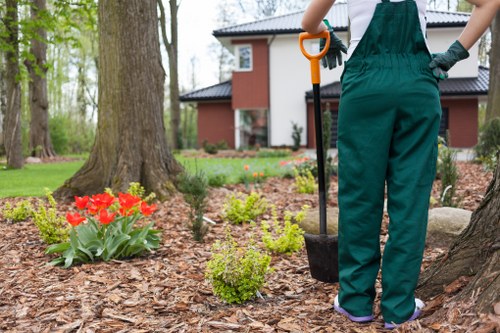Hedge Trimming in Richmond

Maintaining your garden’s aesthetic appeal requires regular upkeep, and one of the essential tasks is hedge trimming. In Richmond, where gardens flourish in a temperate climate, proper hedge trimming not only enhances the beauty of your landscape but also promotes the health and longevity of your plants.
Whether you’re a seasoned gardener or a homeowner looking to improve your outdoor space, understanding the nuances of hedge trimming in Richmond can make a significant difference. This comprehensive guide delves into the various aspects of hedge trimming, providing you with the knowledge and tools needed to achieve pristine hedges all year round.
From selecting the right tools to mastering trimming techniques, we cover everything you need to know to keep your hedges looking their best. Additionally, we explore the benefits of hiring professional services versus tackling the task yourself, helping you make an informed decision that suits your needs and budget.
Why Hedge Trimming is Essential

Hedge trimming is more than just a cosmetic exercise. Regular trimming plays a crucial role in maintaining the shape and size of your hedges, preventing them from becoming overgrown and unruly. Properly trimmed hedges can significantly enhance the overall appearance of your garden, providing structure and framing your outdoor spaces beautifully.
Moreover, hedge trimming promotes the health of the plants. By removing dead or diseased branches, you allow for better air circulation and sunlight penetration, which are vital for the growth and vitality of your hedges. This practice helps in preventing the spread of pests and diseases, ensuring that your hedges remain lush and green throughout the year.
In Richmond’s unique climate, which experiences a mix of mild winters and warm summers, timely hedge trimming can help your plants adapt to seasonal changes, reducing stress and promoting robust growth. It also encourages the hedges to flower and fruit, adding to the diversity and vibrancy of your garden.
Benefits of Regular Hedge Trimming

- Enhanced Aesthetics: Well-trimmed hedges improve the visual appeal of your property.
- Promotes Health: Removes diseased or damaged branches, fostering healthier growth.
- Controlled Growth: Prevents hedges from becoming too large and unmanageable.
- Increased Longevity: Helps hedges live longer by reducing stress and promoting robust foliage.
- Improved Airflow: Enhances air circulation, reducing the risk of fungal diseases.
When to Trim Hedges in Richmond

Timing is crucial when it comes to hedge trimming. In Richmond, the best time to trim hedges typically depends on the type of plants and the specific climate conditions. Generally, the ideal periods for trimming are late winter or early spring before new growth begins, and late summer after the plants have fully bloomed.
Trimming during these times encourages vigorous growth and ensures that the hedges maintain their shape and density. Avoid trimming during extreme weather conditions, such as the peak of summer or during frost, as this can stress the plants and make them more susceptible to diseases.
Additionally, regular maintenance trimming throughout the growing season can help manage the shape and size of your hedges, preventing the need for more drastic measures later on. This proactive approach ensures that your hedges remain healthy and visually appealing all year round.
Seasonal Considerations for Hedge Trimming

- Spring: Encourage new growth by trimming before the growing season starts.
- Summer: Light trimming to maintain shape and remove any overgrown branches.
- Fall: Prepare hedges for winter by removing any weak or diseased branches.
- Winter: Minimal trimming; focus on protecting hedges from extreme cold.
Tools and Equipment for Effective Hedge Trimming

Having the right tools is essential for efficient and precise hedge trimming. In Richmond, where the climate can be both humid and dry, selecting durable and reliable equipment ensures that your trimming tasks are completed effectively without damaging the plants.
Basic tools for hedge trimming include:
- Hedge Shears: Ideal for small to medium-sized hedges, providing precise cuts.
- Electric or Gas-Powered Hedge Trimmers: Suitable for larger hedges, offering faster and more efficient trimming.
- Pruning Saws: Necessary for cutting through thick or woody branches.
- Loppers: Used for trimming branches that are too thick for shears.
- Protective Gear: Gloves, safety glasses, and sturdy footwear to ensure safety during trimming.
Choosing the Right Hedge Trimmers

When selecting hedge trimmers, consider the size of your hedges and the frequency of use. For smaller gardens, manual or electric hedge trimmers may suffice, providing precision and control. However, for larger properties with extensive hedges, gas-powered trimmers may be more efficient, covering larger areas in less time.
Additionally, ergonomics play a significant role in your comfort and efficiency. Look for trimmers with adjustable handles and lightweight designs to reduce fatigue during prolonged use. Regular maintenance of your tools, such as sharpening blades and cleaning equipment after use, will also extend their lifespan and ensure optimal performance.
Techniques for Trimming Hedges

Mastering the right trimming techniques is crucial for achieving well-shaped and healthy hedges. Here are some essential techniques to keep in mind:
- Heading Cuts: Remove the top part of the hedge to encourage bushier growth.
- Thinning Cuts: Reduce the density of the hedge by removing some branches without altering the overall shape.
- Shaping: Use a consistent pattern to maintain a uniform appearance, whether you prefer a formal or informal look.
- Selective Pruning: Focus on removing dead, damaged, or diseased branches to promote healthy growth.
- Maintenance Trimming: Regularly trim the edges and sides to keep the hedge neat and well-defined.
Step-by-Step Guide to Trimming Hedges

Follow these steps for effective hedge trimming:
- Inspect the Hedge: Identify areas that need trimming, such as overgrown branches or uneven sections.
- Choose the Right Time: Trim during the optimal season to promote healthy growth.
- Prepare Your Tools: Ensure all tools are clean, sharp, and in good working condition.
- Start Trimming: Begin by trimming the sides, then move to the top, maintaining consistent shapes.
- Clean Up: Remove all trimmings and dispose of them properly to prevent the spread of pests or diseases.
DIY Hedge Trimming vs. Professional Services

Deciding between DIY hedge trimming and hiring professional services depends on several factors, including the size of your hedges, your skill level, and the time you can dedicate to the task. While DIY trimming can be cost-effective and rewarding, professional services offer expertise and efficiency, especially for large or complex hedges.
Professional hedge trimmers in Richmond have the knowledge and equipment to handle any trimming job, ensuring precise cuts and maintaining the health of your plants. They can also provide valuable advice on hedge care and maintenance, helping you achieve long-term results.
On the other hand, DIY trimming allows you to control every aspect of the process, from shaping to timing. With the right tools and techniques, you can achieve excellent results without the additional cost of hiring professionals.
Pros and Cons of Hiring Professionals

- Pros:
- Expertise and experience for better results.
- Access to specialized tools and equipment.
- Time-saving and efficient.
- Reduced risk of damaging plants.
- Cons:
- Higher cost compared to DIY.
- Scheduling and availability issues.
- Less control over the trimming process.
Cost Factors in Hedge Trimming

The cost of hedge trimming services in Richmond can vary based on several factors. These include the size and height of the hedges, the density of the foliage, the complexity of the job, and the specific services required. Additional services such as cleanup, disposal of trimmings, and pest control can also influence the overall cost.
For DIY enthusiasts, the primary costs involve purchasing or renting the necessary tools and equipment. While this can be a more economical option initially, it's important to consider the maintenance and potential replacement costs of these tools over time.
When opting for professional services, it’s advisable to obtain multiple quotes and compare the offerings of different providers. Look for companies with a good reputation, positive reviews, and transparent pricing to ensure you receive quality service at a fair price.
Average Pricing for Professional Hedge Trimming

- Small Hedges: $50 - $100 per edging.
- Medium Hedges: $100 - $200 per job.
- Large Hedges: $200 - $500 or more, depending on complexity.
- Additional Services: $50 - $150 for cleanup and disposal.
Choosing the Right Hedge for Your Richmond Garden

Selecting the appropriate hedge plants is essential for achieving a lush and manageable garden. Richmond’s climate supports a variety of hedging plants, each with its unique characteristics and maintenance requirements.
Common hedge plants suitable for Richmond include:
- Boxwood: Known for its dense foliage and versatility in shaping.
- Privet: Fast-growing and excellent for creating privacy screens.
- Yew: Evergreen with a robust structure, ideal for formal hedges.
- Holly: Attractive berries and shiny leaves add visual interest.
- Laurel: Dense and tall, perfect for sound barriers.
Factors to Consider When Choosing Hedge Plants

When selecting hedge plants for your Richmond garden, consider the following factors:
- Growth Rate: Determine how quickly the plants grow to manage future trimming needs.
- Climate Suitability: Ensure the plants are well-suited to Richmond’s climate and soil conditions.
- Maintenance Requirements: Choose plants that match your willingness to perform regular maintenance.
- Desired Aesthetic: Select plants that complement the overall design of your garden.
- Height and Density: Consider the privacy and screening needs of your outdoor space.
Tips for Maintaining Healthy Hedges

Maintaining healthy and attractive hedges involves more than just regular trimming. Here are some essential tips to keep your hedges in optimal condition:
- Proper Watering: Ensure your hedges receive adequate water, especially during dry spells.
- Fertilization: Apply appropriate fertilizers to promote healthy growth and vibrant foliage.
- Pest Control: Monitor for signs of pests and diseases, and take prompt action to address any issues.
- Pruning Techniques: Use correct pruning methods to avoid damaging the plants and encourage healthy regrowth.
- Mulching: Apply mulch around the base of the hedges to retain moisture and suppress weeds.
Avoiding Common Hedge Trimming Mistakes

Even with the best intentions, it’s easy to make mistakes when trimming hedges. Avoid these common errors to ensure your hedges remain healthy and attractive:
- Over-Trimming: Cutting too much can stress the plants and inhibit growth.
- Incorrect Timing: Trimming at the wrong time of year can damage the plants and disrupt their natural growth cycle.
- Using Dull Tools: Dull blades can cause uneven cuts and increase the risk of disease.
- Ignoring Plant Type: Different hedge plants have specific trimming requirements; failing to consider this can lead to improper maintenance.
- Neglecting Safety: Always use protective gear and follow safety guidelines to prevent accidents.
Environmental Benefits of Well-Trimmed Hedges

Beyond aesthetics and plant health, well-trimmed hedges offer several environmental benefits. They contribute to air quality by absorbing carbon dioxide and releasing oxygen, creating a more breathable environment. Additionally, hedges can serve as natural windbreaks, reducing soil erosion and protecting other plants from harsh weather conditions.
Hedging also provides habitats for various wildlife, including birds and beneficial insects, promoting biodiversity in your garden. By maintaining your hedges, you support local ecosystems and contribute to a healthier environment.
Moreover, strategic trimming can enhance energy efficiency by providing shade during the summer months and acting as a barrier against cold winds in the winter, potentially reducing heating and cooling costs for your home.
Sustainable Hedge Trimming Practices

- Use Eco-Friendly Tools: Opt for electric or manual tools to minimize carbon emissions.
- Compost Trimmings: Recycle hedge clippings by composting them, enriching your soil naturally.
- Water Conservation: Implement efficient watering practices to maintain healthy hedges without overusing water resources.
- Integrated Pest Management: Employ natural pest control methods to protect your hedges and the surrounding environment.
- Reduce Chemical Use: Limit the use of chemical fertilizers and pesticides, opting for organic alternatives instead.
Local Regulations and Guidelines for Hedge Trimming in Richmond

When trimming hedges in Richmond, it’s important to be aware of any local regulations or community guidelines that may affect your gardening practices. Some neighborhoods or homeowner associations may have specific rules regarding the height, shape, and placement of hedges to maintain a uniform look across the community.
Additionally, certain hedging plants might be restricted due to their environmental impact or potential to disrupt local ecosystems. Always check with local authorities or community boards before undertaking significant trimming projects to ensure compliance with any relevant regulations.
Being informed about local guidelines not only helps you avoid potential fines or disputes but also contributes to maintaining a harmonious and aesthetically pleasing neighborhood environment.
Obtaining Permits for Large-Scale Trimming

For large-scale hedge trimming or significant alterations to your garden landscape, you might need to obtain permits from local authorities. This is especially true if your hedges are part of a property boundary or if they are considered heritage or protected plants.
Before starting any major trimming project, consult with the Richmond city council or relevant municipal departments to determine if a permit is required. This proactive approach ensures that your project adheres to local laws and avoids any legal complications.
Additionally, obtaining professional advice from certified horticulturists or landscape architects can provide insights into the best practices for compliant and effective hedge trimming.
Conclusion: Elevate Your Garden with Expert Hedge Trimming

Hedge trimming in Richmond is an essential practice for maintaining the beauty, health, and functionality of your garden. By understanding the importance of regular trimming, selecting the right tools, and employing proper techniques, you can achieve stunning hedges that enhance your outdoor space.
Whether you choose to undertake the task yourself or hire professional services, investing time and effort into hedge maintenance pays off in the long run. Healthy, well-maintained hedges not only elevate the aesthetic appeal of your property but also provide numerous environmental benefits, contributing to a greener and more sustainable community.
Embrace the art of hedge trimming and transform your Richmond garden into a thriving, picturesque haven that you can enjoy for years to come. Contact us today or book your service now to ensure your hedges receive the care and attention they deserve.